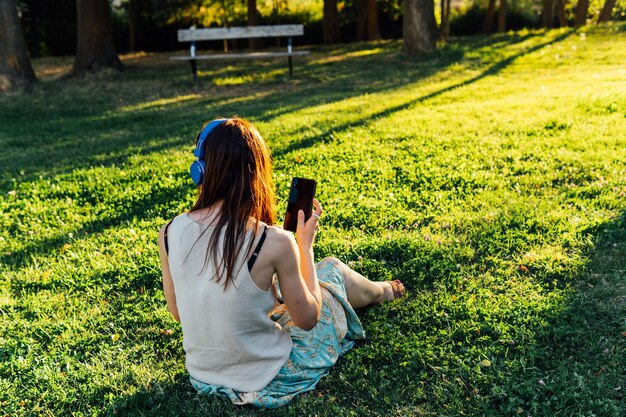Mindful Tech Use in 2025: Reclaim 2 Hours of Your Day

The Updated 2025 Guide to Mindful Tech Use offers practical strategies to help you regain control over your digital habits, reduce screen time, and reclaim up to two hours of your day for activities that truly matter.
Is technology ruling your life? Discover The Updated 2025 Guide to Mindful Tech Use: Reclaim 2 Hours of Your Day, designed to help you break free from digital overload and rediscover joy in the real world.
Understanding Mindful Tech Use
Mindful tech use is about intentionally engaging with technology in a way that supports your well-being, rather than detracting from it. It’s about making conscious choices about when, how, and why you use technology.
What is Mindful Technology?
Mindful technology isn’t about avoiding tech altogether. It’s about using it in a way that aligns with your values and goals. It involves being present and aware of your interactions with devices and applications.
Why is it important in 2025?
In 2025, technology will be even more integrated into our lives. This makes mindful tech use more critical than ever to maintain our mental and emotional health, preventing burnout and promoting a healthier relationship with screens.
- ⏰ Promotes better focus and concentration
- 😌 Reduces stress and anxiety related to constant connectivity
- ❤️ Enhances real-life relationships and experiences
- 💡 Supports overall well-being and mental health
By intentionally managing our tech use, we can create a more balanced and fulfilling lifestyle.
Assessing Your Current Tech Habits
Before implementing changes, it’s crucial to understand your current tech habits. Knowing where your time goes helps identify areas where you can cut back and practice mindfulness.

Tracking Your Screen Time
Most smartphones and tablets have built-in features to track your screen time. Use these tools to see how much time you spend on different apps and websites. Identify patterns and triggers that lead to mindless scrolling.
Identifying Time-Wasting Apps
Some apps are designed to be addictive, constantly vying for your attention. Identify those apps that offer little value and consume significant amounts of your time. These are prime candidates for reduction or elimination.
Once you’ve identified where your time is going, you can begin making intentional decisions to change your behavior.
- 📊 Use built-in screen time trackers on your devices.
- ✍️ Keep a daily log of your tech use for a week.
- 🤔 Reflect on how technology affects your mood and productivity.
Setting Intentional Boundaries
Setting boundaries is essential for reclaiming your time. Establishing clear limits on when and how you use technology can help you regain control and prevent digital distractions from taking over your life.
Creating Tech-Free Zones
Designate certain areas in your home as tech-free zones. This could be the dining table, bedroom, or any space where you want to focus on being present. Enforce a no-device policy in these areas.
Scheduling Tech-Free Time
Allocate specific times in your day for disconnecting from technology. This could be during meals, before bed, or during leisure activities. Use this time to engage in activities that don’t involve screens, such as reading, exercising, or spending time with loved ones.

By setting clear boundaries, you create space for more meaningful experiences.
- 📅 Schedule specific times for checking emails and social media.
- 📵 Use app timers to limit the amount of time you spend on certain apps.
- 🔕 Turn off notifications to reduce constant distractions.
Mindful Alternatives to Tech Use
Replacing screen time with more fulfilling activities is critical for a balanced life. These alternatives provide stimulation and relaxation without the negative effects of excessive tech use.
Engaging in Hobbies
Rediscover old hobbies or explore new ones. Activities like painting, gardening, playing a musical instrument, or crafting can provide a sense of accomplishment and joy. Hobbies engage your mind and body in a positive way.
Connecting with Nature
Spending time in nature has numerous benefits for mental and physical health. Take a walk in the park, go for a hike, or simply sit outside and enjoy the scenery. Nature reduces stress and promotes a sense of calm.
Choosing mindful alternatives helps you break free from the endless cycle of digital consumption.
- 📚 Read a book.
- 🧘 Practice meditation or yoga.
- 🚶 Take a walk or hike.
Leveraging Technology Mindfully
Technology can also be used mindfully to enhance your life and well-being. Using apps and tools designed to promote balance and mindfulness can be a positive way to integrate tech into your daily routine.
Using Mindfulness Apps
There are numerous apps designed to promote mindfulness, meditation, and relaxation. Apps like Headspace, Calm, and Insight Timer offer guided meditations, breathing exercises, and sleep stories to help you reduce stress and improve your mental well-being.
Utilizing Productivity Tools
Productivity apps can help you stay organized and focused on your tasks. Use tools like Trello, Asana, or Todoist to manage your projects and prioritize your goals. These apps can help you use technology more efficiently and intentionally.
The key is to use technology as a tool to support your goals, rather than a source of distraction.
- 🗓️ Use calendar reminders for breaks.
- 👍 Select apps that have mindful use features.
- 🔎 Explore tools for managing social media use.
Overcoming Challenges and Staying Consistent
Changing your relationship with technology takes time and effort. It’s important to be patient with yourself and persistent in your efforts. Expect to encounter challenges along the way, and have strategies in place to overcome them.
Dealing with FOMO
Fear of missing out (FOMO) is a common challenge when reducing tech use. Recognize that it’s impossible to stay connected to everything all the time. Focus on the present moment and the experiences you are actively participating in.
Staying Motivated
Find ways to stay motivated on your journey to mindful tech use. Set realistic goals, reward yourself for progress, and seek support from friends or family. Remember the benefits you are working towards, such as reduced stress, improved focus, and enhanced relationships.
Consistency is key to forming new habits and maintaining a healthy relationship with technology.
- 🤝 Find an accountability partner to stay on track.
- 🎉 Celebrate small victories to stay motivated.
- 💖 Practice self-compassion when you slip up.
| Key Point | Brief Description |
|---|---|
| 📱 Assess Tech Habits | Track screen time to identify time-wasting apps. |
| 🚫 Set Boundaries | Create tech-free zones and schedule device-free time. |
| 🌳 Find Alternatives | Engage in hobbies and connect with nature. |
| 🧘Use Tech Mindfully | Utilize apps designed for mindfulness and productivity. |
FAQ
▼
Mindful tech use involves intentionally engaging with technology to support your well-being, rather than mindlessly consuming it. It focuses on conscious choices about when and how you use digital devices.
▼
Most smartphones and tablets have built-in features to track your screen time. You can find this information in your device’s settings, usually under “Digital Wellbeing” or “Screen Time”.
▼
Tech-free activities can include reading a physical book, spending time in nature, exercising, practicing meditation, or engaging in hobbies such as painting or playing a musical instrument.
▼
Acknowledge your feelings of FOMO, but remind yourself of the benefits of unplugging. Focus on the present moment and the activities you are actively participating in, rather than what you might be missing online.
▼
Popular mindfulness apps include Headspace, Calm, and Insight Timer. These apps offer guided meditations, breathing exercises, and sleep stories to help you reducedaily stress and improve your mental well-being.
Conclusion
In conclusion, adopting The Updated 2025 Guide to Mindful Tech Use is a proactive step towards reclaiming your time and enhancing your well-being. By assessing your tech habits, setting intentional boundaries, and practicing mindful alternatives, you can create a healthier, more balanced lifestyle that prioritizes your mental and emotional health.





